fuse SKODA RAPID 2012 1.G Owner's Manual
[x] Cancel search | Manufacturer: SKODA, Model Year: 2012, Model line: RAPID, Model: SKODA RAPID 2012 1.GPages: 180, PDF Size: 4.36 MB
Page 6 of 180
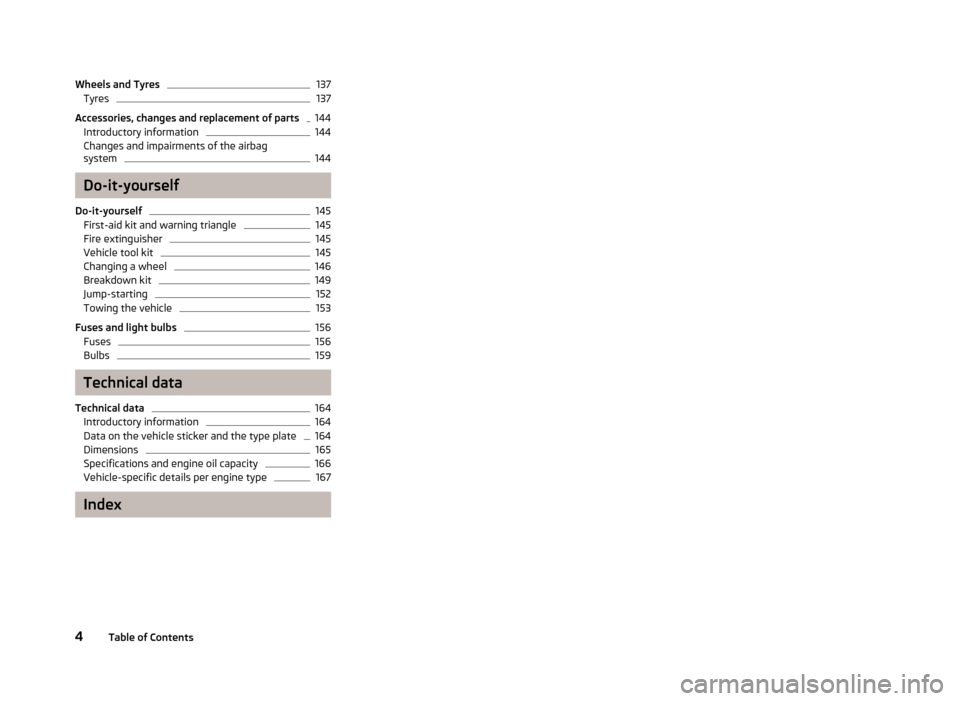
Wheels and Tyres 137
Tyres 137
Accessories, changes and replacement of parts 144
Introductory information 144
Changes and impairments of the airbag
system 144
Do-it-yourself
Do-it-yourself 145
First-aid kit and warning triangle 145
Fire extinguisher 145
Vehicle tool kit 145
Changing a wheel 146
Breakdown kit 149
Jump-starting 152
Towing the vehicle 153
Fuses and light bulbs 156
Fuses 156
Bulbs 159
Technical data
Technical data 164
Introductory information 164
Data on the vehicle sticker and the type plate 164
Dimensions 165
Specifications and engine oil capacity 166
Vehicle-specific details per engine type 167
Index
4 Table of Contents
Page 9 of 180
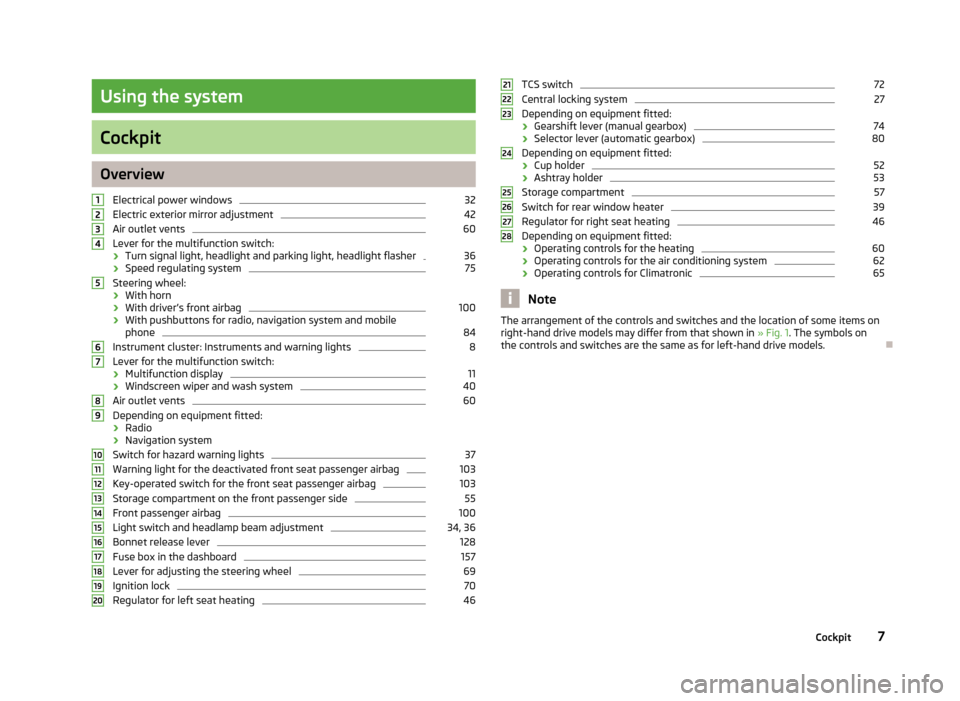
Using the system
Cockpit
Overview
Electrical power windows 32
Electric exterior mirror adjustment 42
Air outlet vents 60
Lever for the multifunction switch:
› Turn signal light, headlight and parking light, headlight flasher 36
› Speed regulating system 75
Steering wheel:
› With horn
› With driver’s front airbag 100
› With pushbuttons for radio, navigation system and mobile
phone 84
Instrument cluster: Instruments and warning lights 8
Lever for the multifunction switch:
› Multifunction display 11
› Windscreen wiper and wash system 40
Air outlet vents 60
Depending on equipment fitted:
› Radio
› Navigation system
Switch for hazard warning lights 37
Warning light for the deactivated front seat passenger airbag 103
Key-operated switch for the front seat passenger airbag 103
Storage compartment on the front passenger side 55
Front passenger airbag 100
Light switch and headlamp beam adjustment 34, 36
Bonnet release lever 128
Fuse box in the dashboard 157
Lever for adjusting the steering wheel 69
Ignition lock 70
Regulator for left seat heating 461
2
3
4
5
6
7
8
9
10
11
12
13
14
15
16
17
18
19
20 TCS switch 72
Central locking system 27
Depending on equipment fitted:
› Gearshift lever (manual gearbox) 74
› Selector lever (automatic gearbox) 80
Depending on equipment fitted:
› Cup holder 52
› Ashtray holder 53
Storage compartment 57
Switch for rear window heater 39
Regulator for right seat heating 46
Depending on equipment fitted:
› Operating controls for the heating 60
› Operating controls for the air conditioning system 62
› Operating controls for Climatronic 65
Note
The arrangement of the controls and switches and the location of some items on
right-hand drive models may differ from that shown in »
Fig. 1. The symbols on
the controls and switches are the same as for left-hand drive models. Ð 21
22
23
24
25
26
27
28
7
Cockpit
Page 21 of 180

The warning light
flashes yellow (engine oil level sensor faulty)
The following is displayed in the information display:
Oil sensor: Workshop!
If the engine oil level sensor is faulty, the warning light flashes several times
and an audible signal sounds when the ignition is turned on.
Seek help from a
ŠKODA specialist garage.WARNING
If you have to stop for technical reasons, then park the vehicle at a safe dis-
tance from the traffic, switch off the engine and activate the hazard warning
light system » page 37. ÐCoolant temperature/coolant level
The indicator light lights up until the engine reaches operating temperature 1)
.
Avoid high speeds, full throttle and high engine loads.
If the warning light lights up or flashes, either the coolant temperature is too
high or the coolant level is too low.
The following is displayed in the information display:
Check coolant! Owner's manual!
Stop the vehicle, switch off the engine, check the level of the coolant » page 130,
and refill the coolant if necessary » page 131.
If the coolant is within the specified range, the increased temperature may be
caused by an operating problem at the radiator fan. Check the fuse for the radia-
tor fan, replace if necessary » page 159, Replacing the fuses in the engine com-
partment .
Do not continue driving if the warning light does not go off even though the
coolant level is correct and the fuse for the fan is in working order!
Seek help from a ŠKODA specialist garage. WARNING
■ If you have to stop for technical reasons, then park the vehicle at a safe dis-
tance from the traffic, switch off the engine and activate the hazard warning
light system » page 37.
■ Carefully open the coolant expansion bottle. If the engine is hot, the cooling
system is pressurized – risk of scalding! It is therefore best to allow the engine
to cool down before removing the cap.
■ Do not touch the radiator fan. The radiator fan may switch itself on auto-
matically even if the ignition is off. Ð Power steering
If the indicator light lights up, there is a fault in the power steering system.
The power steering operates with reduced steering assist or does not function at
all.
Seek help from a
ŠKODA specialist garage. Ð Electronic Stability Control (ESC)
The warning light flashes to show that the ESC is currently operating.
If the warning light comes on immediately after you start the engine, the ESC
might be switched off due to technical reasons. Switch the ignition off and on
again. If the warning light does not light up after you switch the engine back on,
the ESR is fully functional again.
If the warning light lights up, there is a fault in the ESC.
The following is displayed in the information display: Error: Electronic Stability Control (ESC)
or Error: traction control (ASR)
Seek help from a ŠKODA specialist garage.
Further information » page 72, Electronic Stability Control (ESC) .£1)
Not valid for vehicles with information display.
19
Instruments and Indicator Lights
Page 36 of 180
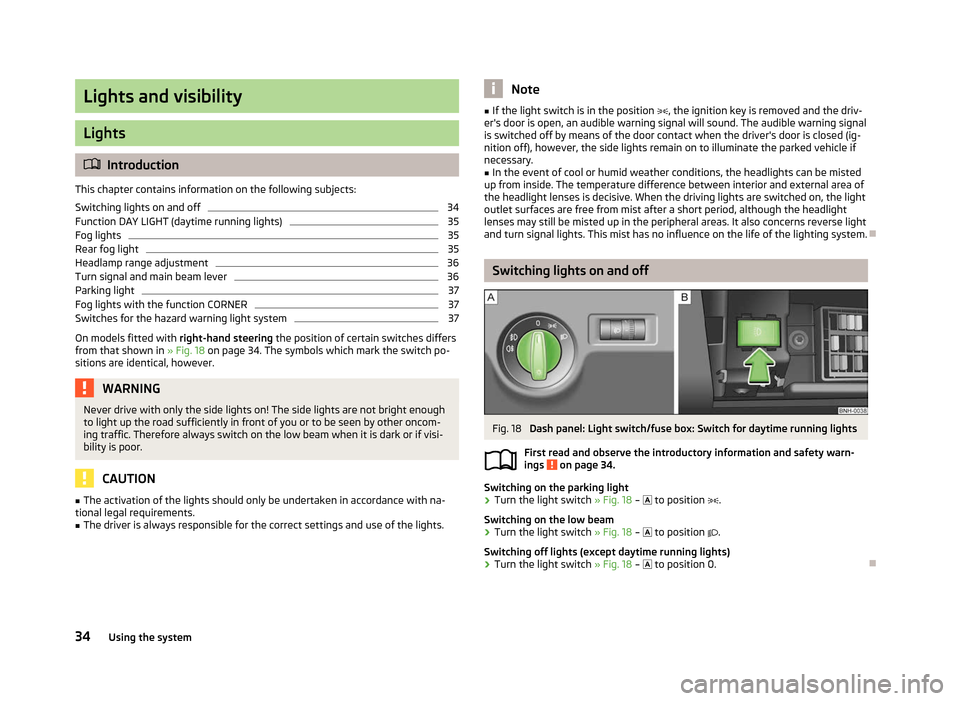
Lights and visibility
Lights
ä
Introduction
This chapter contains information on the following subjects:
Switching lights on and off 34
Function DAY LIGHT (daytime running lights) 35
Fog lights 35
Rear fog light 35
Headlamp range adjustment 36
Turn signal and main beam lever 36
Parking light 37
Fog lights with the function CORNER 37
Switches for the hazard warning light system 37
On models fitted with right-hand steering the position of certain switches differs
from that shown in » Fig. 18 on page 34. The symbols which mark the switch po-
sitions are identical, however. WARNING
Never drive with only the side lights on! The side lights are not bright enough
to light up the road sufficiently in front of you or to be seen by other oncom-
ing traffic. Therefore always switch on the low beam when it is dark or if visi-
bility is poor. CAUTION
■ The activation of the lights should only be undertaken in accordance with na-
tional legal requirements.
■ The driver is always responsible for the correct settings and use of the lights. Note
■ If the light switch is in the position , the ignition key is removed and the driv-
er's door is open, an audible warning signal will sound. The audible warning signal
is switched off by means of the door contact when the driver's door is closed (ig-
nition off), however, the side lights remain on to illuminate the parked vehicle if
necessary. ■ In the event of cool or humid weather conditions, the headlights can be misted
up from inside. The temperature difference between interior and external area of
the headlight lenses is decisive. When the driving lights are switched on, the light
outlet surfaces are free from mist after a short period, although the headlight
lenses may still be misted up in the peripheral areas. It also concerns reverse light
and turn signal lights. This mist has no influence on the life of the lighting system. Ð Switching lights on and off
Fig. 18
Dash panel: Light switch/fuse box: Switch for daytime running lights
First read and observe the introductory information and safety warn-
ings on page 34.
Switching on the parking light
›
Turn the light switch
» Fig. 18 – to position .
Switching on the low beam
› Turn the light switch
» Fig. 18 – to position .
Switching off lights (except daytime running lights)
› Turn the light switch
» Fig. 18 – to position 0.Ð
ä
34 Using the system
Page 37 of 180
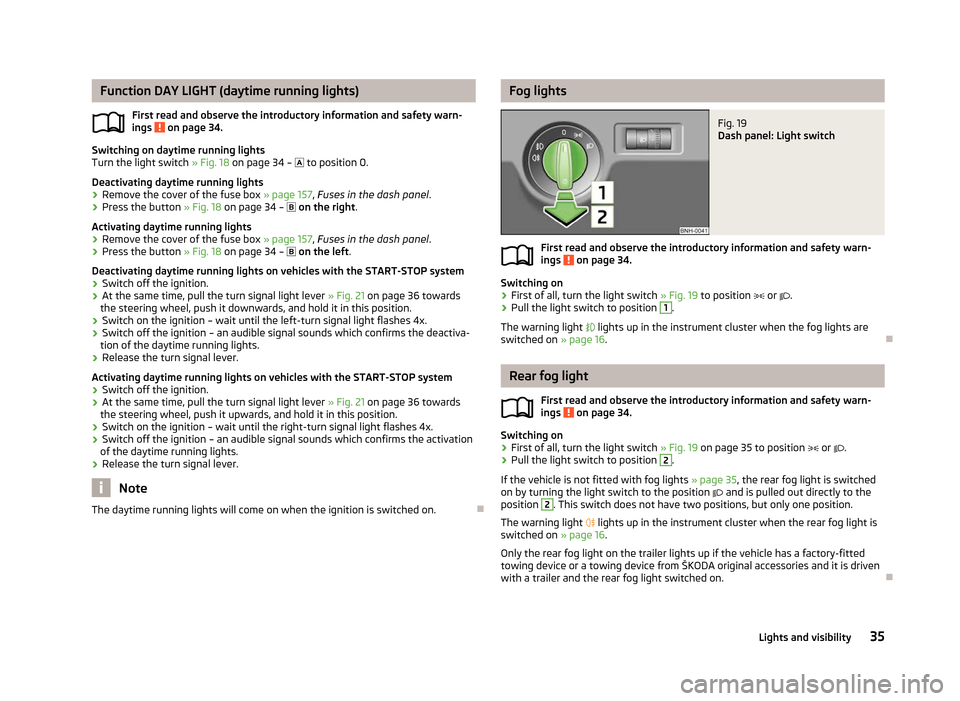
Function DAY LIGHT (daytime running lights)
First read and observe the introductory information and safety warn-
ings on page 34.
Switching on daytime running lights
Turn the light switch
» Fig. 18 on page 34 – to position 0.
Deactivating daytime running lights
› Remove the cover of the fuse box
» page 157, Fuses in the dash panel.
› Press the button
» Fig. 18 on page 34 – on the right.
Activating daytime running lights
› Remove the cover of the fuse box
» page 157, Fuses in the dash panel.
› Press the button
» Fig. 18 on page 34 – on the left .
Deactivating daytime running lights on vehicles with the START-STOP system
› Switch off the ignition.
› At the same time, pull the turn signal light lever
» Fig. 21 on page 36 towards
the steering wheel, push it downwards, and hold it in this position.
› Switch on the ignition – wait until the left-turn signal light flashes 4x.
› Switch off the ignition – an audible signal sounds which confirms the deactiva-
tion of the daytime running lights.
› Release the turn signal lever.
Activating daytime running lights on vehicles with the
START-STOP system
› Switch off the ignition.
› At the same time, pull the turn signal light lever
» Fig. 21 on page 36 towards
the steering wheel, push it upwards, and hold it in this position.
› Switch on the ignition – wait until the right-turn signal light flashes 4x.
› Switch off the ignition – an audible signal sounds which confirms the activation
of the daytime running lights.
› Release the turn signal lever. Note
The daytime running lights will come on when the ignition is switched on. Ð
ä Fog lights
Fig. 19
Dash panel: Light switch
First read and observe the introductory information and safety warn-
ings on page 34.
Switching on
›
First of all, turn the light switch
» Fig. 19 to position or .
› Pull the light switch to position 1
.
The warning light lights up in the instrument cluster when the fog lights are
switched on » page 16. Ð Rear fog light
First read and observe the introductory information and safety warn-
ings on page 34.
Switching on
›
First of all, turn the light switch
» Fig. 19 on page 35 to position or .
› Pull the light switch to position 2
.
If the vehicle is not fitted with fog lights » page 35, the rear fog light is switched
on by turning the light switch to the position and is pulled out directly to the
position 2
. This switch does not have two positions, but only one position.
The warning light
lights up in the instrument cluster when the rear fog light is
switched on » page 16.
Only the rear fog light on the trailer lights up if the vehicle has a factory-fitted
towing device or a towing device from ŠKODA original accessories and it is driven
with a trailer and the rear fog light switched on. Ð
ä
ä
35
Lights and visibility
Page 61 of 180
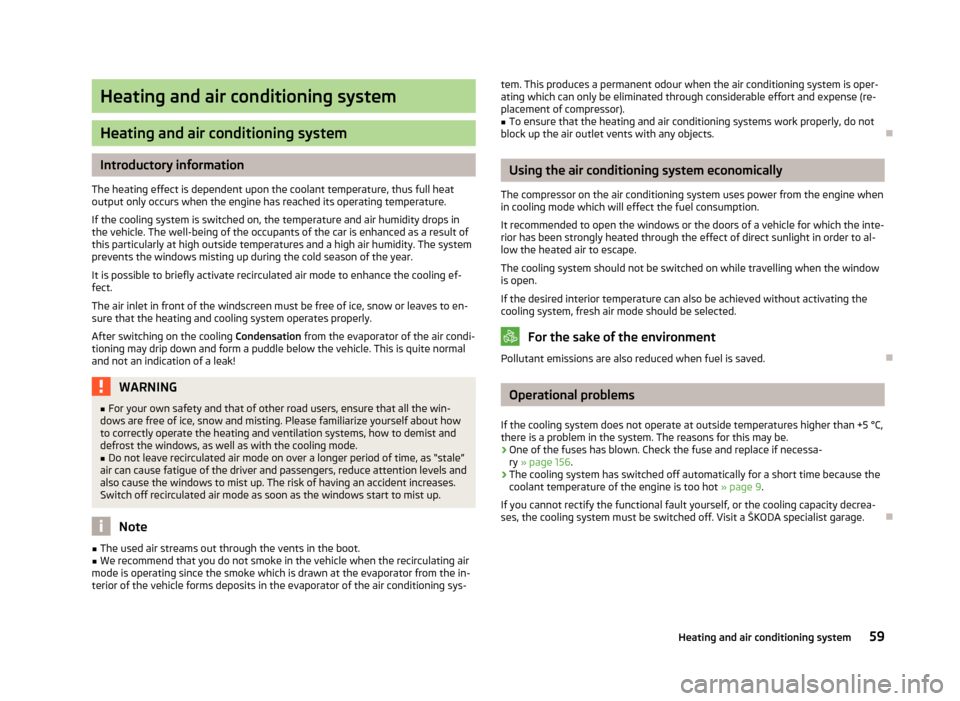
Heating and air conditioning system
Heating and air conditioning system
Introductory information
The heating effect is dependent upon the coolant temperature, thus full heat
output only occurs when the engine has reached its operating temperature.
If the cooling system is switched on, the temperature and air humidity drops in
the vehicle. The well-being of the occupants of the car is enhanced as a result of
this particularly at high outside temperatures and a high air humidity. The system
prevents the windows misting up during the cold season of the year.
It is possible to briefly activate recirculated air mode to enhance the cooling ef-
fect.
The air inlet in front of the windscreen must be free of ice, snow or leaves to en-
sure that the heating and cooling system operates properly.
After switching on the cooling Condensation from the evaporator of the air condi-
tioning may drip down and form a puddle below the vehicle. This is quite normal
and not an indication of a leak! WARNING
■ For your own safety and that of other road users, ensure that all the win-
dows are free of ice, snow and misting. Please familiarize yourself about how
to correctly operate the heating and ventilation systems, how to demist and
defrost the windows, as well as with the cooling mode.
■ Do not leave recirculated air mode on over a longer period of time, as “stale”
air can cause fatigue of the driver and passengers, reduce attention levels and
also cause the windows to mist up. The risk of having an accident increases.
Switch off recirculated air mode as soon as the windows start to mist up. Note
■ The used air streams out through the vents in the boot.
■ We recommend that you do not smoke in the vehicle when the recirculating air
mode is operating since the smoke which is drawn at the evaporator from the in-
terior of the vehicle forms deposits in the evaporator of the air conditioning sys- tem. This produces a permanent odour when the air conditioning system is oper-
ating which can only be eliminated through considerable effort and expense (re-
placement of compressor). ■ To ensure that the heating and air conditioning systems work properly, do not
block up the air outlet vents with any objects. Ð Using the air conditioning system economically
The compressor on the air conditioning system uses power from the engine when
in cooling mode which will effect the fuel consumption.
It recommended to open the windows or the doors of a vehicle for which the inte-
rior has been strongly heated through the effect of direct sunlight in order to al-
low the heated air to escape.
The cooling system should not be switched on while travelling when the window
is open.
If the desired interior temperature can also be achieved without activating the
cooling system, fresh air mode should be selected. For the sake of the environment
Pollutant emissions are also reduced when fuel is saved. Ð Operational problems
If the cooling system does not operate at outside temperatures higher than +5 °C,
there is a problem in the system. The reasons for this may be.
› One of the fuses has blown. Check the fuse and replace if necessa-
ry »
page 156 .
› The cooling system has switched off automatically for a short time because the
coolant temperature of the engine is too hot » page 9.
If you cannot rectify the functional fault yourself, or the cooling capacity decrea-
ses, the cooling system must be switched off. Visit a ŠKODA specialist garage. Ð
59
Heating and air conditioning system
Page 71 of 180

For the sake of the environment
Do not warm up the engine while the vehicle is stationary. If possible, start your
journey as soon as the engine has started. Through this the engine reaches its
operating temperature more rapidly and the pollutant emissions are lower. Note
■ The engine can only be started with a genuine ŠKODA key with the matching
code. ■ The engine running noises may louder at first be louder for a short time after
starting the cold engine. This is quite normal and is not an operating problem. ■ After switching off the ignition, the radiator fan can intermittently continue to
operate for approx. 10
minutes.
■ If the engine does not start up after a second attempt, the fuse for the fuel
pump may have a fault. Check the fuse and replace, if necessary » page 157,
Fuses in the dash panel
or seek assistance from a ŠKODA specialist garage.
■ We recommend locking the steering wheel
whenever leaving the vehicle. This
acts as a deterrent against the attempted theft of your car. ÐAdjusting the steering wheel position
Fig. 62
Adjustable steering wheel: Lever below the steering column/safe
distance to the steering wheel
First read and observe the introductory information and safety warn-
ings on page 68.
The height and forward/back position of the steering wheel can be adjusted.
›
First of all adjust the driver's seat
» page 44, Front seats.
› Pull the lever below the steering wheel down
» Fig. 62 – .
ä ›
Adjust the steering wheel to the desired position (with regard to the height and
forward/back position).
› Push the lever upwards to the stop. Ð Power steering
First read and observe the introductory information and safety warn-
ings on page 68.
The power steering enables you to steer the vehicle with less physical force.
It is still possible to fully steer the vehicle if the power steering fails or if the en-
gine is not running (vehicle being towed in). However, greater physical effort is
required to turn the steering wheel. Ð Electronic immobiliser
First read and observe the introductory information and safety warn-
ings on page 68.
An electronic chip is integrated in the head of the key. The immobiliser is deacti-
vated with the aid of this chip when the key is inserted in the ignition lock. The
electronic immobiliser is automatically activated when the ignition key is with-
drawn from the lock.
The engine will not start if a non-authorized ignition key is used.
The following is displayed in the information display: Immobilizer active. Ð
ä
ä
69
Starting-off and Driving
Page 85 of 180
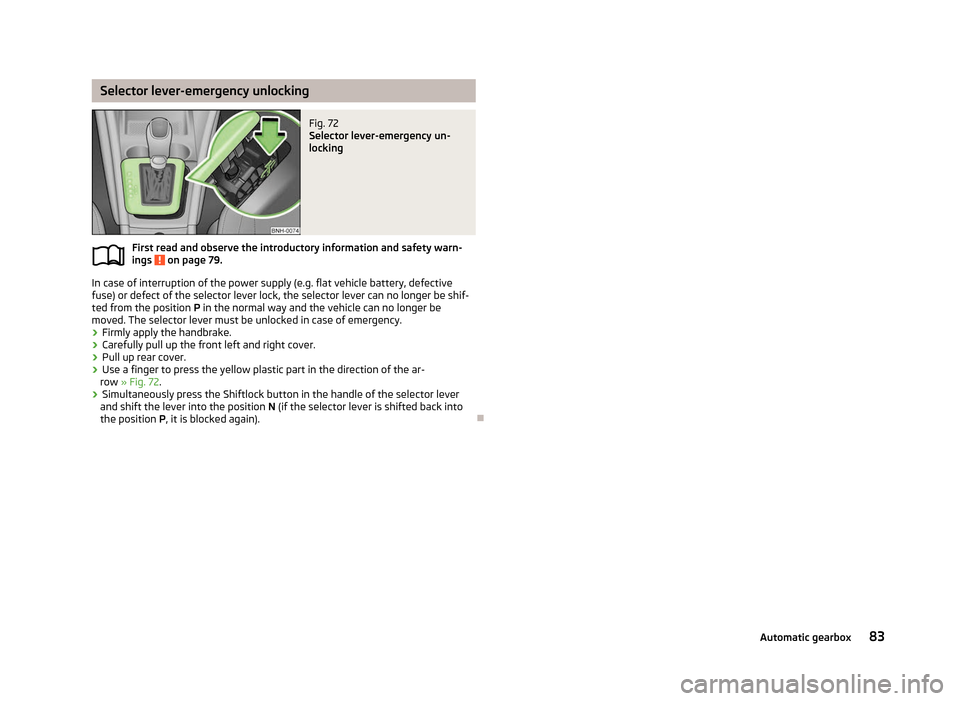
Selector lever-emergency unlocking
Fig. 72
Selector lever-emergency un-
locking
First read and observe the introductory information and safety warn-
ings on page 79.
In case of interruption of the power supply (e.g. flat vehicle battery, defective
fuse) or defect of the selector lever lock, the selector lever can no longer be shif-
ted from the position
P in the normal way and the vehicle can no longer be
moved. The selector lever must be unlocked in case of emergency.
› Firmly apply the handbrake.
› Carefully pull up the front left and right cover.
› Pull up rear cover.
› Use a finger to press the yellow plastic part in the direction of the ar-
row » Fig. 72.
› Simultaneously press the Shiftlock button in the handle of the selector lever
and shift the lever into the position N (if the selector lever is shifted back into
the position P , it is blocked again). Ðä
83
Automatic gearbox
Page 158 of 180
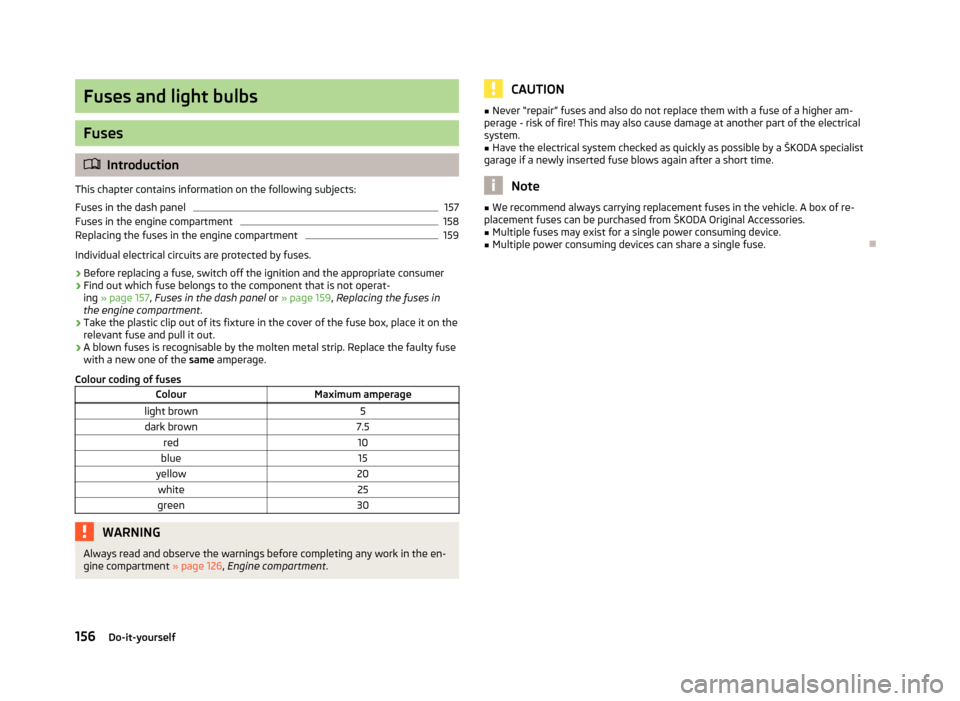
Fuses and light bulbs
Fuses
ä
Introduction
This chapter contains information on the following subjects:
Fuses in the dash panel 157
Fuses in the engine compartment 158
Replacing the fuses in the engine compartment 159
Individual electrical circuits are protected by fuses.
› Before replacing a fuse, switch off the ignition and the appropriate consumer
› Find out which fuse belongs to the component that is not operat-
ing » page 157 , Fuses in the dash panel or » page 159 , Replacing the fuses in
the engine compartment .
› Take the plastic clip out of its fixture in the cover of the fuse box, place it on the
relevant fuse and pull it out.
› A blown fuses is recognisable by the molten metal strip. Replace the faulty fuse
with a new one of the
same amperage.
Colour coding of fuses Colour Maximum amperage
light brown 5
dark brown 7.5
red 10
blue 15
yellow 20
white 25
green 30WARNING
Always read and observe the warnings before completing any work in the en-
gine compartment » page 126, Engine compartment . CAUTION
■ Never “repair” fuses and also do not replace them with a fuse of a higher am-
perage - risk of fire! This may also cause damage at another part of the electrical
system.
■ Have the electrical system checked as quickly as possible by a ŠKODA specialist
garage if a newly inserted fuse blows again after a short time. Note
■ We recommend always carrying replacement fuses in the vehicle. A box of re-
placement fuses can be purchased from
ŠKODA Original Accessories.
■ Multiple fuses may exist for a single power consuming device.
■ Multiple power consuming devices can share a single fuse. Ð
156 Do-it-yourself
Page 159 of 180
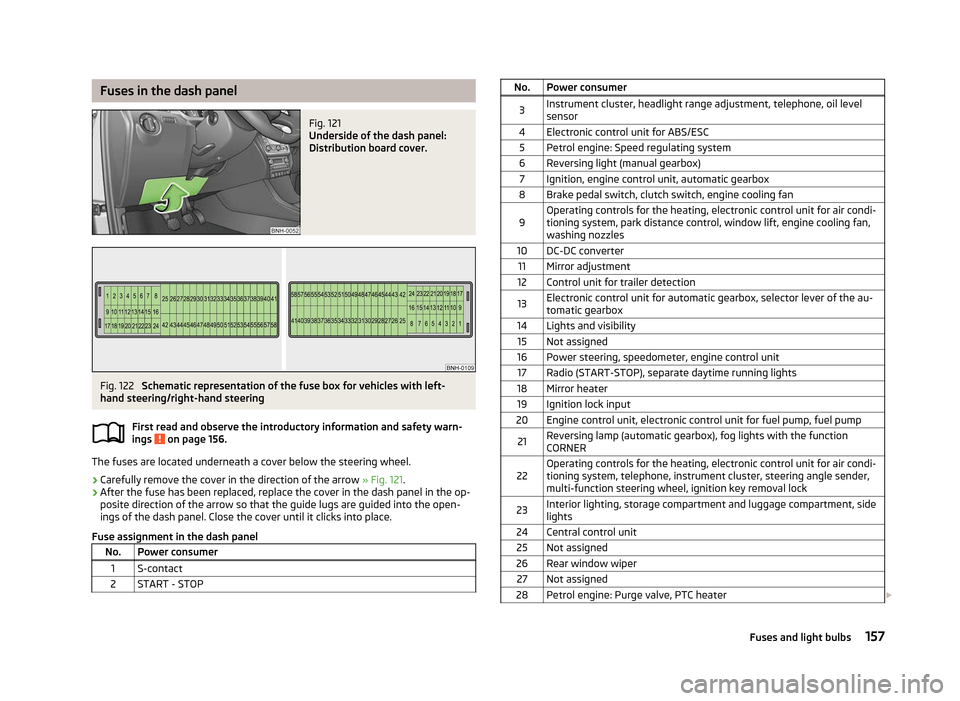
Fuses in the dash panel
Fig. 121
Underside of the dash panel:
Distribution board cover. Fig. 122
Schematic representation of the fuse box for vehicles with left-
hand steering/right-hand steering
First read and observe the introductory information and safety warn-
ings on page 156.
The fuses are located underneath a cover below the steering wheel.
› Carefully remove the cover in the direction of the arrow
» Fig. 121.
› After the fuse has been replaced, replace the cover in the dash panel in the op-
posite direction of the arrow so that the guide lugs are guided into the open-
ings of the dash panel. Close the cover until it clicks into place.
Fuse assignment in the dash panel No. Power consumer
1 S-contact
2 START - STOP ä No. Power consumer
3 Instrument cluster, headlight range adjustment, telephone, oil level
sensor
4 Electronic control unit for ABS/ESC 5 Petrol engine: Speed regulating system
6 Reversing light (manual gearbox) 7 Ignition, engine control unit, automatic gearbox
8 Brake pedal switch, clutch switch, engine cooling fan
9 Operating controls for the heating, electronic control unit for air condi-
tioning system, park distance control, window lift, engine cooling fan,
washing nozzles
10 DC-DC converter 11 Mirror adjustment
12 Control unit for trailer detection
13 Electronic control unit for automatic gearbox, selector lever of the au-
tomatic gearbox
14 Lights and visibility 15 Not assigned
16 Power steering, speedometer, engine control unit 17 Radio (START-STOP), separate daytime running lights
18 Mirror heater 19 Ignition lock input
20 Engine control unit, electronic control unit for fuel pump, fuel pump
21 Reversing lamp (automatic gearbox), fog lights with the function
CORNER
22 Operating controls for the heating, electronic control unit for air condi-
tioning system, telephone, instrument cluster, steering angle sender,
multi-function steering wheel, ignition key removal lock
23 Interior lighting, storage compartment and luggage compartment, side
lights
24 Central control unit 25 Not assigned
26 Rear window wiper 27 Not assigned
28 Petrol engine: Purge valve, PTC heater £ 157
Fuses and light bulbs